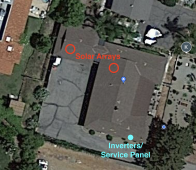I recently installed a PV array 150 feet from my inverters. I have two EG4 6500EXs. They have an AC Input from my utility company service panel which has is earth grounded. The inverters then feeds my critical load panel. Is it standard practice to run a 150 ft 6 AWG bare copper wire from the PV rails (IronRidge equipment so that the rails and panels are grounded together) to the inverter, thus grounding the system through to the utility company service panel? Or should I instead put grounding rods in at the array and run the copper wire there instead?
In this commonly circulated video from Mike Holt on grounding, he mentions that you want to keep a grounding electric conductor as short as possible (32:08 in this video).
In this commonly circulated video from Mike Holt on grounding, he mentions that you want to keep a grounding electric conductor as short as possible (32:08 in this video).
Last edited:



